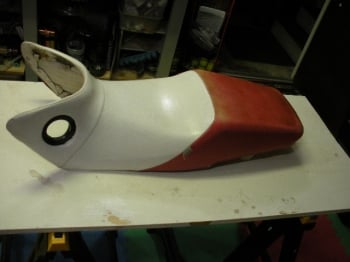How to Fix Sun-Damaged Car and Motorcycle Seats
You may notice that, over time, your soft leather car or motorcycle seats become dry or faded. Many people attribute this to wear and tear, but it is actually caused by heat and light from the sun.
Because the leather in your vehicle is likely to be exposed to a lot of sunlight and heat in parking lots, vehicle manufacturers use leather that is highly resistant to sun damage in their seats. Even then, the risk is there. Let’s see how to manage it.

Some basic advice to start
Most car seats are made from fully finished leather, which tends to hold up much longer in the sun than other types of leather. However, even the strongest leathers will be damaged by heat and sunlight over time, so it’s a good idea to clean and protect your seats 6-8 times a year to boost their resistance to damage.
You can also try using window shields in a car or covers on a bike to keep some of the light and heat off your leather if you park in the sun for extended periods of time.
It is also a good idea to seek out parking spots in the shade instead of in direct sunlight.
Understanding sun damage
Sun damage to car and motorcycle seats is a gradual process that occurs due to prolonged exposure to ultraviolet (UV) rays.
These rays break down the molecular structure of seat materials, leading to a range of visible and structural issues. Understanding how sun exposure affects different seat materials can help you take appropriate steps to prevent and repair damage.
How sun exposure affects seat materials
Leather: Leather seats are particularly susceptible to sun damage. The UV rays can cause the natural oils in leather to evaporate, leading to dryness, cracking, and fading. Over time, leather can become brittle and develop unsightly cracks that not only mar its appearance but also compromise its durability.
Vinyl: Vinyl seats are less expensive and more durable than leather, but they are not immune to sun damage. UV rays can cause vinyl to become discolored, brittle, and prone to cracking. Unlike leather, vinyl does not have natural oils, so it can deteriorate more quickly without proper care.
Fabric: Fabric seats, while generally more resistant to temperature fluctuations, can still suffer from sun damage. Prolonged exposure to the sun can cause fabric to fade, weaken, and become threadbare. Additionally, the heat can cause the fabric to degrade, leading to tears and worn spots.
Signs of sun damage
Recognizing the early signs of sun damage can help you address issues before they become severe. Common signs of sun damage include:
- Fading: The color of the seats becomes lighter and less vibrant.
- Cracking: Visible cracks or splits in the material, especially in leather and vinyl.
- Dryness: The material feels dry and brittle to the touch.
- Discoloration: Uneven or blotchy color patches, often seen in vinyl.
- Weakened Fabric: Fabric seats may appear worn, thin, or frayed in certain areas.
By understanding these signs and the specific ways sun exposure affects different materials, you can take the necessary steps to repair and protect your car or motorcycle seats effectively.
How to DIY fix sun-damaged car and motorcycle seats
You can have a leather professional re-dye faded leather for a reasonable cost. But, once the natural oils found in leather are gone, they’re gone for good.
Leather professionals can do a number of things to make it look better, but there is no way to truly restore it to its previous condition. That’s why preventative maintenance is so important!
Preparation
Before diving into the repair process, it’s crucial to prepare properly. Preparation involves gathering the necessary tools and materials, selecting a suitable work area, and taking precautions to ensure a successful and safe repair.
Gathering Necessary Tools and Materials
To repair sun-damaged seats, you’ll need the following tools and materials:
Cleaning Supplies:
- Mild soap or leather cleaner
- Water
- Soft cloths or sponges
- Vacuum cleaner (for fabric seats)
Repair Kits:
- Leather repair kit (includes filler, colorant, and sealant)
- Vinyl repair kit (includes filler and colorant)
- Fabric repair kit or fabric dye (for fixing fading or small tears)
Protective Gear:
- Gloves (to protect your hands from chemicals)
- Masks (to avoid inhaling fumes from repair products)
Additional Items:
- Sandpaper (for smoothing out rough areas)
- Small brush or applicator (for applying fillers and dyes)
- UV protectant (to prevent future sun damage)
Choosing a Suitable Work Area
Selecting an appropriate work area is essential for achieving the best results. Consider the following factors:
Ventilation: Ensure the area is well-ventilated, especially when working with chemicals and repair products. If you’re working indoors, open windows and use fans to improve air circulation.
Shade: Choose a shaded area to prevent the repair products from drying too quickly and to avoid additional sun exposure to the seats during the repair process.
Cleanliness: Work in a clean environment to prevent dust and debris from contaminating the repair area. Lay down a tarp or protective covering to keep the workspace tidy.
Precautions
Taking a few precautions can help ensure a smooth repair process:
Read Instructions: Carefully read the instructions provided with the repair kits and cleaning products. Each product may have specific application methods and drying times.
Test Products: Before applying any cleaning or repair products to the seats, test them on a small, inconspicuous area to ensure they do not cause further damage or discoloration.
Protect Surrounding Areas: Use masking tape and plastic sheets to protect parts of the vehicle that you don’t want to get cleaning solutions or repair products on, such as the dashboard, console, and door panels.
Proper preparation sets the stage for a successful repair. By gathering the right tools and materials, choosing a suitable work area, and taking necessary precautions, you can effectively address sun damage and restore your seats to their former glory.
Cleaning the Seats
Proper cleaning is a crucial first step before beginning any repair work on sun-damaged seats. Cleaning removes dirt, oils, and other contaminants that can interfere with the effectiveness of repair products. Here’s a detailed step-by-step guide to cleaning seats made from different materials.
Step-by-Step Cleaning Process
- Removing Dust and Debris:
- Leather and Vinyl: Use a soft brush or vacuum cleaner with a brush attachment to gently remove dust and debris from the seat surfaces and crevices.
- Fabric: Vacuum the seats thoroughly to remove loose dirt, dust, and debris. Use the upholstery attachment for best results.
- Cleaning Leather Seats:
- Cleaning Solution: Mix a small amount of mild soap or leather cleaner with water. Avoid using harsh chemicals that can strip the leather of its natural oils.
- Application: Dampen a soft cloth with the cleaning solution and gently wipe down the leather seats. Focus on one section at a time.
- Drying: Use a clean, dry cloth to wipe away any excess moisture. Allow the seats to air dry completely.
- Cleaning Vinyl Seats:
- Cleaning Solution: Use a mixture of mild soap and water or a dedicated vinyl cleaner.
- Application: Apply the solution to a soft cloth or sponge and wipe the vinyl surfaces. Be gentle to avoid scratching or further damaging the material.
- Drying: Wipe off any excess moisture with a clean cloth and let the seats air dry.
- Cleaning Fabric Seats:
- Spot Cleaning: For stains or heavily soiled areas, use an upholstery cleaner or a mixture of water and mild soap. Apply the cleaner to a soft cloth and gently blot the stained area.
- Overall Cleaning: For a more thorough cleaning, use a fabric cleaner or upholstery shampoo. Follow the product instructions for application and use a soft brush to work the cleaner into the fabric.
- Rinsing and Drying: Use a clean, damp cloth to rinse away any soap or cleaner residue. Allow the seats to dry completely before proceeding to the next step.
Tips for Thorough Cleaning
- Avoid Saturation: Do not soak the seats with water or cleaning solution, as excessive moisture can cause further damage, especially in leather and fabric seats.
- Gentle Techniques: Use gentle motions and soft materials to avoid scratching or further damaging the seat surfaces.
- Regular Maintenance: Incorporate regular cleaning into your vehicle maintenance routine to prevent the buildup of dirt and oils that can accelerate sun damage.
Properly cleaned seats provide a solid foundation for any repair work. By removing dirt, oils, and other contaminants, you ensure that repair products can adhere properly and work effectively.
Repairing Leather Seats
Leather seats, while luxurious and comfortable, are prone to damage from prolonged sun exposure. Cracks, fading, and dryness are common issues that can make leather car seats look worn and neglected. Here’s a step-by-step guide to repairing sun-damaged leather seats.
Assessing the Extent of the Damage
Before starting the repair process, evaluate the condition of your leather seats:
- Minor Damage: Includes slight fading, small cracks, and surface dryness.
- Moderate Damage: Involves more noticeable cracks, larger faded areas, and stiffness in the leather.
- Severe Damage: Consists of deep cracks, extensive fading, and brittleness that may require professional intervention.
Minor Repairs: Using Leather Conditioners and Cleaners
For minor damage, leather conditioners and cleaners can help restore moisture and color:
- Cleaning: Ensure the leather is clean and dry before applying any products.
- Conditioning: Apply a high-quality leather conditioner using a soft cloth. Work it into the leather using circular motions. Let it sit for the recommended time, then wipe off any excess.
- Buffing: After conditioning, buff the leather with a clean cloth to restore its natural shine.
Dealing with Cracks and Tears: Applying Leather Repair Kits
For more severe cracks and tears, a leather repair kit is necessary. Follow these steps for a professional-looking repair:
- Cleaning the Area:
- Preparation: Clean the damaged area with a leather cleaner to remove any dirt and oils.
- Drying: Ensure the area is completely dry before proceeding.
- Applying Filler and Coloring:
- Filler: Use the leather filler included in the repair kit to fill in cracks and tears. Apply it using a small spatula or the applicator provided.
- Smoothing: Smooth out the filler with a damp cloth or sponge to ensure it blends seamlessly with the surrounding leather. Allow it to dry completely.
- Coloring: Apply the colorant from the repair kit to match the original leather color. Use a small brush or sponge to apply thin, even layers. Let each layer dry before applying the next until the desired color is achieved.
- Finishing with a Leather Sealant:
- Sealant Application: Once the colorant is dry, apply the leather sealant to protect the repaired area. This helps lock in the color and adds a protective layer to the leather.
- Drying: Allow the sealant to dry completely before using the seats.
Preventive Measures: Regular Conditioning and Use of Seat Covers
To prevent future sun damage, implement the following preventive measures:
- Regular Conditioning: Apply a leather conditioner every 3-6 months to keep the leather moisturized and supple.
- Use of Seat Covers: Consider using seat covers, especially if your vehicle is frequently exposed to the sun. This provides an additional layer of protection against UV rays.
- Parking in Shade: Whenever possible, park your vehicle in shaded areas or use sunshades to minimize direct sunlight exposure.
By following these steps, you can effectively repair sun-damaged leather seats and maintain their appearance and durability for years to come.
Repairing Vinyl Seats
Vinyl seats are known for their durability and lower maintenance compared to leather, but they are still susceptible to sun damage. Cracks, discoloration, and brittleness are common issues. Here’s a detailed guide on how to repair sun-damaged vinyl seats.
Identifying Common Issues with Sun-Damaged Vinyl
Before starting repairs, identify the specific problems with your vinyl seats:
- Discoloration: Fading or changes in color due to UV exposure.
- Cracks and Tears: Surface cracks or deeper tears caused by prolonged sun exposure.
- Brittleness: The vinyl becomes hard and brittle, making it prone to cracking.
Using Vinyl Repair Kits for Small Cracks and Tears
For minor cracks and small tears, a vinyl repair kit is an effective solution. Here’s how to use it:
- Cleaning the Damaged Area:
- Cleaning: Use a mild soap and water solution or a vinyl cleaner to clean the damaged area thoroughly. This removes dirt, oils, and any residues that might interfere with the repair.
- Drying: Make sure the area is completely dry before applying any repair products.
- Applying Vinyl Filler and Colorant:
- Filler: Use the vinyl filler provided in the repair kit to fill in cracks and small tears. Apply it with a spatula or the applicator included in the kit.
- Smoothing: Smooth out the filler with a damp cloth or your finger, ensuring it blends well with the surrounding vinyl. Allow it to dry as per the manufacturer’s instructions.
- Colorant: Match the colorant in the kit to the color of your vinyl seats. Apply it in thin, even layers using a small brush or sponge. Let each layer dry before applying the next until the desired color match is achieved.
- Sealing the Repair:
- Sealant: Once the colorant is dry, apply a vinyl sealant to protect the repaired area. This helps ensure durability and provides a protective coating.
- Drying: Allow the sealant to dry completely before using the seats. This might take several hours, so plan accordingly.
Preventive Measures: UV Protectants and Seat Covers
To extend the life of your vinyl seats and prevent future sun damage, consider these preventive measures:
Regular Application of UV Protectants:
- UV Protectant Spray: Use a UV protectant spray designed for vinyl seats. Apply it regularly to create a protective barrier against UV rays. Follow the product instructions for application frequency.
Use of Seat Covers:
- Seat Covers: Invest in high-quality seat covers that provide an additional layer of protection against the sun. Choose covers that are specifically designed for your vehicle’s make and model for the best fit and coverage.
Parking in Shaded Areas:
- Shade: Whenever possible, park your vehicle in shaded areas or use a car cover. This reduces direct sun exposure and helps prevent the vinyl from becoming brittle and discolored.
By following these steps, you can repair sun-damaged vinyl seats effectively and maintain their appearance and durability. Regular maintenance and the use of protective measures can significantly extend the life of your vinyl seats.
Protecting Seats from Future Sun Damage
Preventing sun damage is key to maintaining the appearance and durability of your car and motorcycle seats. Implementing a few simple practices can protect your seats from the harmful effects of UV rays and keep them looking new for longer.
Importance of Regular Maintenance and Protection
Regular maintenance and protection are essential for the longevity of your seats. Without proper care, seats can quickly degrade due to UV exposure, leading to costly repairs or replacements. Consistent upkeep not only preserves the aesthetic appeal of your vehicle’s interior but also maintains its resale value.
Tips for Daily Care and Protection
Here are some practical tips to protect your seats from future sun damage:
Using Sunshades and Seat Covers:
- Sunshades: Invest in high-quality sunshades for your windshield and windows. These can significantly reduce the amount of UV light entering your vehicle, protecting your seats from direct sunlight and reducing interior temperatures.
- Seat Covers: Use seat covers made from UV-resistant materials. These covers provide an extra layer of protection against the sun’s rays and can be easily removed and cleaned. Choose covers that fit well and complement your vehicle’s interior.
Parking in Shaded Areas:
- Shade: Whenever possible, park your vehicle in shaded areas such as garages, carports, or under trees. This simple step can greatly reduce sun exposure and heat buildup inside the vehicle.
- Car Covers: If shaded parking is not available, consider using a full car cover when parking for extended periods. Car covers offer comprehensive protection against UV rays and other environmental elements.
Regular Cleaning and Conditioning:
- Cleaning: Regularly clean your seats to remove dirt, oils, and other contaminants that can accelerate sun damage. Use appropriate cleaners for your seat material (leather, vinyl, or fabric).
- Conditioning: For leather seats, apply a leather conditioner every 3-6 months to keep the material moisturized and supple. Conditioning helps prevent drying and cracking caused by UV exposure.
- Fabric Protection: Use fabric protectant sprays to shield fabric seats from UV rays and stains. These sprays create a protective barrier that helps maintain the color and integrity of the fabric.
Using UV Protectant Sprays:
- UV Protectant: Apply a UV protectant spray specifically designed for automotive interiors. These sprays form a protective layer on the surface of your seats, preventing UV rays from penetrating and causing damage. Follow the product instructions for application and reapplication intervals.
Preventive Measures for Long-Term Protection
Routine Inspections:
- Regular Checks: Periodically inspect your seats for signs of sun damage, such as fading, cracking, or dryness. Early detection allows for timely repairs and prevents minor issues from becoming major problems.
Professional Maintenance:
- Detailing Services: Consider professional detailing services for your vehicle’s interior. Professionals can thoroughly clean and condition your seats, apply UV protectants, and address any existing damage.
- Reupholstery: For severely damaged seats, professional reupholstery may be necessary. Choose UV-resistant materials for reupholstery to ensure long-term protection.
By incorporating these practices into your routine, you can effectively protect your car and motorcycle seats from future sun damage. Regular maintenance, the use of protective products, and mindful parking habits are all essential in preserving the look and functionality of your vehicle’s interior for years to come.
Fibrenew can’t block out the sun, but we can fix your seats
Get in touch with your local Fibrenew professional for all your leather, plastic, and vinyl repair needs.
Want to run a business that gives you incredible earning potential and the flexibility to take control of your time and life? Join the Fibrenew Family!
Check out our free Franchise Information Report for everything you need to know.
Also, enjoy these valuable resources on all things leather, plastic, and vinyl repair, franchising, sustainability, and more:
What are the first steps to take when I notice sun damage on my car or motorcycle seats? The first steps are to thoroughly clean the seats to remove any dirt and debris. Use appropriate cleaning agents for your seat material (leather, vinyl, or fabric). After cleaning, assess the extent of the damage to determine whether minor repairs or more extensive restoration is needed. Can I repair small cracks in leather seats myself, or do I need professional help? Small cracks in leather seats can typically be repaired at home using a leather repair kit. These kits include fillers, colorants, and sealants that can help restore the appearance and functionality of the leather. For deep or extensive cracks, seeking professional help might be more effective. How can I restore the color of faded fabric seats? To restore the color of faded fabric seats, you can use fabric dyes or sprays. First, clean the seats thoroughly, then apply the dye or spray according to the manufacturer’s instructions. Ensure even coverage and allow the dye to dry completely before using the seats. What products can help prevent future sun damage to my seats? UV protectant sprays, seat covers, and sunshades are effective products for preventing future sun damage. UV protectant sprays form a protective barrier against UV rays, while seat covers and sunshades reduce direct sun exposure. Regular conditioning for leather seats and fabric protectant sprays for fabric seats also help maintain their integrity. Is it worth reupholstering severely sun-damaged seats, and what should I consider?FAQ: Fixing Sun-Damaged Car and Motorcycle Seats









